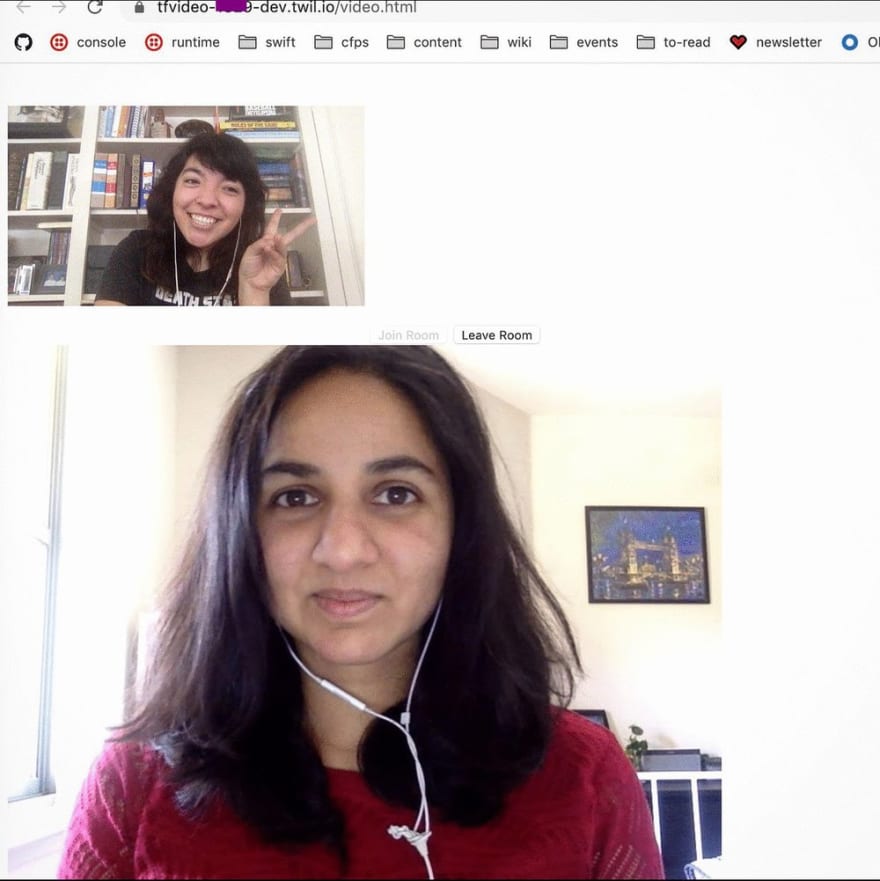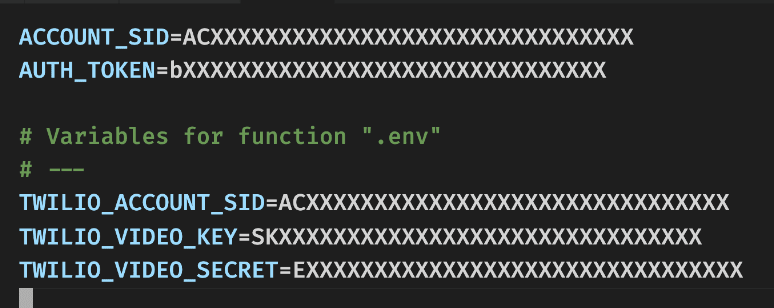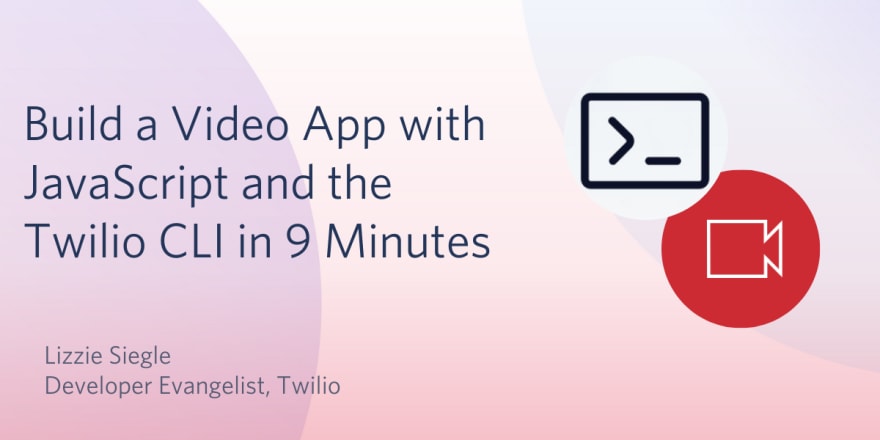An Interest In:
Web News this Week
- March 20, 2024
- March 19, 2024
- March 18, 2024
- March 17, 2024
- March 16, 2024
- March 15, 2024
- March 14, 2024
Build a Video App with JavaScript and the Twilio CLI in 9 Minutes
With many of us now working remote, video chats are so in right now. Heres how to get up-and-running with a video chat room in nine minutes using Twilio Programmable Video and the Twilio Serverless Toolkit in JavaScript.
Setup
To build a Twilio Programmable Video application, we will need:
- A Twilio account - sign up for a free one here and receive an extra $10 if you upgrade through this link
- Account SID: find it in your account console here
- API Key SID and API Key Secret: generate them here
- The Twilio CLI
Save your API Keys somewhere you can access them soon and then install the Twilio Serverless Toolkit via the Twilio CLI if you haven't already by running
twilio plugins:install @twilio-labs/plugin-serverlessYou can then see what commands the Serverless Toolkit offers by running
twilio serverlessMake a Serverless Project
Create a Serverless project with a blank template by running on the command line
twilio serverless:init --template blank {insert-project-name}Replace {insert-project-name} with your project name--I called mine tfvideo. When the command completes, a directory with the project name will be created under your current directory.
The project directory contains some ready-made folders. In functions, add a file called video-token.js and in assets add two files: video.html and index.js. Set your environment variables in .env. You can leave the first two lines containing ACCOUNT_SID and AUTH_TOKEN alone. Below them, add your Account SID, API Key, and API Secret:
Generate an Access Token
In functions/video-token.js add the following code to generate an access token. Here we set your environment variables, a fixed room name, and the ACCESS_TOKEN_IDENTITY for each user. Each user is granted access to the room tf. This code was modified from this page which also contains more information on Access Tokens.
exports.handler = function(context, event, callback) { const TWILIO_ACCOUNT_SID = context.TWILIO_ACCOUNT_SID; const TWILIO_API_KEY = context.TWILIO_API_KEY; const TWILIO_API_SECRET = context.TWILIO_API_SECRET; const ACCESS_TOKEN_IDENTITY = Math.random() .toString(36) .substring(2, 15) + Math.random() .toString(36) .substring(2, 15); // random client name const ROOM_NAME = 'tf'; // fixed room name const AccessToken = Twilio.jwt.AccessToken; const VideoGrant = AccessToken.VideoGrant; // only tokens are available for participating rooms // Create a Video grant enabling client to use Video, only for this room const videoGrant = new VideoGrant({ room: ROOM_NAME }); //Create an access token to sign and return to the client with the grant we just created const accessToken = new AccessToken( TWILIO_ACCOUNT_SID, TWILIO_API_KEY, TWILIO_API_SECRET ); accessToken.addGrant(videoGrant); //Add the grant to the token accessToken.identity = ACCESS_TOKEN_IDENTITY; callback(null, { token: accessToken.toJwt() //Serialize the token to a JWT string });};Make our Video Site
Now open the blank assets/video.html file you made earlier. We're going to write some bare-bones HTML including buttons for joining and leaving the room, a video tag that will automatically display a preview of the user's camera, the index.js file we're about to write, and the Axios and Twilio Video.js libraries:
<!DOCTYPE html><html> <head> <meta charset="utf-8"> <meta http-equiv="X-UA-Compatible"> <meta name="viewport" content="width=device-width, initial-scale=1"> <title>Twilio Video Serverless Demo</title></head> <body> <div id="room-controls"> <video id="video" autoplay muted="true" width="320" height="240"></video> <button id="button-join">Join Room</button> <button id="button-leave" disabled>Leave Room</button> </div> <script src="//media.twiliocdn.com/sdk/js/video/releases/2.3.0/twilio-video.min.js"></script> <script src="https://unpkg.com/[email protected]/dist/axios.min.js"></script> <script src="index.js"></script> </body></html>Build the Video App
In assets/index.js add the following code. In a nutshell, this copy-and-pasteable script will:
- set the serverless domain name (this will be the base URL) as whatever you called your project with the CLI template
- set the name of your room name, and some variables
- get the video element and display it in the preview screen
- generate an access token using an
axios call to thevideo-tokenfile when a user joins the room - connect and disconnect users to the
tfroom when they clickbutton-joinorbutton-leave - display a remote participant's video by attaching an event listener to subscribe or unsubscribe their tracks to the
tfroom. If they are already in the room, we iterate over the existingparticipantsand attach an event listener totrackSubscribed.
If you change the room name, you must also change the token that's generated.
(() => { 'use strict'; const TWILIO_DOMAIN = location.host; //unique to user, will be website to visit for video app const ROOM_NAME = 'tf'; const Video = Twilio.Video; let videoRoom, localStream; const video = document.getElementById("video"); // preview screen navigator.mediaDevices.getUserMedia({video: true, audio: true}) .then(vid => { video.srcObject = vid; localStream = vid; }) // buttons const joinRoomButton = document.getElementById("button-join"); const leaveRoomButton = document.getElementById("button-leave"); var site = `https://${TWILIO_DOMAIN}/video-token`; console.log(`site ${site}`); joinRoomButton.onclick = () => { // get access token axios.get(`https://${TWILIO_DOMAIN}/video-token`).then(async (body) => { const token = body.data.token; console.log(token); Video.connect(token, { name: ROOM_NAME }).then((room) => { console.log(`Connected to Room ${room.name}`); videoRoom = room; room.participants.forEach(participantConnected); room.on("participantConnected", participantConnected); room.on("participantDisconnected", participantDisconnected); room.once("disconnected", (error) => room.participants.forEach(participantDisconnected) ); joinRoomButton.disabled = true; leaveRoomButton.disabled = false; }); }); }; leaveRoomButton.onclick = () => { videoRoom.disconnect(); console.log(`Disconnected from Room ${videoRoom.name}`); joinRoomButton.disabled = false; leaveRoomButton.disabled = true; };})();const participantConnected = (participant) => { console.log(`Participant ${participant.identity} connected'`); const div = document.createElement('div'); div.id = participant.sid; participant.on('trackSubscribed', track => trackSubscribed(div, track)); participant.on('trackUnsubscribed', trackUnsubscribed); participant.tracks.forEach(publication => { if (publication.isSubscribed) { trackSubscribed(div, publication.track); } }); document.body.appendChild(div);}const participantDisconnected = (participant) => { console.log(`Participant ${participant.identity} disconnected.`); document.getElementById(participant.sid).remove();}const trackSubscribed = (div, track) => { div.appendChild(track.attach());}const trackUnsubscribed = (track) => { track.detach().forEach(element => element.remove());}Yes, this has been Programmable Video demystified and simplified!
On the command line, run twilio serverless:deploy. The CLI will congratulate you with Serverless project successfully deployed and some other deployment details. You can delete or ignore functions/blank.js which was deployed with the auto-generated assets. Grab the video.html URL under Assets, share it with your friends, and tada! You have your own video room to use and share when you need a quick video call.
This app is pretty bare-bones but definitely decent given the lack of CSS written, eh? The complete code can be found here on GitHub.
What's Next
Twilio's Serverless Toolkit makes it easy to host apps and get them up-and-running quickly. Next you can write some more CSS to prettify the app, add a programmable chat feature or more Twilio Video features, get users' names and display them when they are in the chat, and more. Let me know online or in the comments what you're building.
- Twitter: [@lizziepika](https://twitter.com/lizziepika
- GitHub: elizabethsiegle
- email: [email protected]
Original Link: https://dev.to/twilio/build-a-video-app-with-javascript-and-the-twilio-cli-in-9-minutes-4fol
Dev To
 An online community for sharing and discovering great ideas, having debates, and making friends
An online community for sharing and discovering great ideas, having debates, and making friendsMore About this Source Visit Dev To


